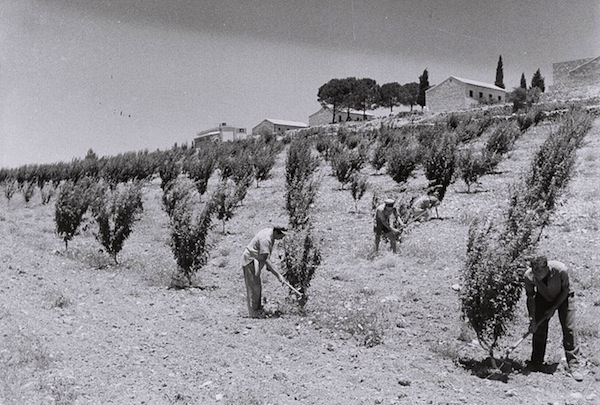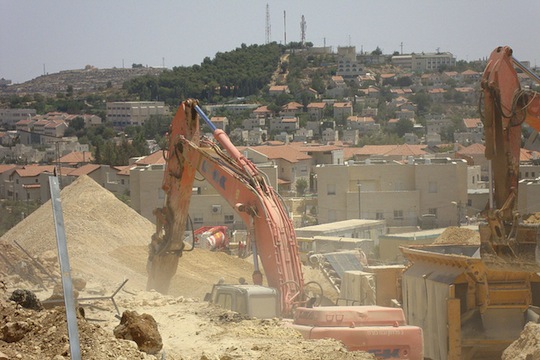Destroyed by Arab armies during the 1948 War, Gush Etzion was repopulated after Israel occupied the West Bank in 1967. Since then, successive Israeli governments have done everything they can to expand the area of the mythological bloc, while settling Israelis on privately-owned Palestinian land.
By Hillel Bardin and Dror Etkes
All American children learn the battle cry, “Remember the Alamo!” at some point in their schooling. The story of the Alamo starts in 1836, when white colonists began settling in northern Mexico. They finally drove the Mexican army out, but the army eventually returned and slaughtered all the whites in the Alamo Mission, refusing to even take prisoners. The white army, infuriated by the slaughter of the heroes of the Alamo, returned with a taste for blood. They beat back the Mexicans and subsequently annexed all of northern Mexico, which then became the state of Texas – the largest in the contiguous United States.
Israeli children do not learn about the Alamo, but they do have their own heroes to remember. In the 1940s, four kibbutzim (Kfar Etzion, Masuot Yitzhak, Revadim and Ein Tzurim) were established southwest of Bethlehem in an area later designated for a Palestinian state by the 1947 UN Partition Plan. It turned out that their location was excellent for intercepting Arab military traffic between Hebron and Jerusalem, so the Haganah and Palmach (pre-state Zionist militias) sent troops and supplies to do just that in the last days of the British Mandate. The Jewish martyrs of Gush Etzion (including the 35 soldiers of the Lamed-Heh) are part of the Israeli pantheon of heroes. Prime Minister Ben-Gurion said that he could “think of no battle in the annals of the Israel Defense Forces that was more magnificent, more tragic or more heroic than the struggle for Gush Etzion.”

While there was debate in 1967 over whether to settle in the West Bank, the resettlement of Gush Etzion was viewed by many Jews as a special case, which derived from the sentimental value over its fate in the 1948 War. On September 27, 1967, Kfar Etzion became the first Jewish settlement in the West Bank, and was re-established on its 1948 ruins. At this point it became apparent that using the name “Gush Etzion” allowed the public to overcome its general resistance to settling Israelis in the occupied West Bank.
This, however, led to the fraud of attaching the name Gush Etzion to areas that had no connection to the original group of settlements – a fraud that was officially endorsed by the Israeli government in 1980, when the military commander of the West Bank officially declared the inauguration of the Gush Etzion Regional Council. From then on, nearly every new settlement between Jerusalem and Hebron was considered to be part of the bloc. The area called “Gush Etzion” today is more than 30 times the size of the historic Gush Etzion.
An additional fraud was then introduced on a national scale. Legalistic arrangements were made in order to allow Israel to declare privately-owned Palestinian land “state land,” which was then turned over to Jewish settlers for development. Although the decision was denounced by the international community as illegal usage of occupied territory, the state’s legal guile was accepted by Israel’s High Court of Justice, giving the green light for building settlements atop private Palestinian land. In this new and artificially-inflated Gush Etzion, thousands of acres were declared “state land,” and were subsequently used to establish dozens of new settlements around Bethlehem.

This crawling land grab continues today. In late 2014, 1,200 acres to both the south and west of Bethlehem were declared “state land” in order to create an Israeli axis that would connect the eastern settlements of Gush Etzion to the Green Line. The expropriation of such a large area is expected to significantly increase the number of Israeli settlers in the area.
Elections in Israel are a time when politicians of all stripes, from Labor to Likud, declare their loyalty to the settlement blocs, and specifically to Gush Etzion. It is time to stop cooperating with Israeli propaganda, which tries to bestow upon every settlement that is falsely described as part of Gush Etzion the aura of the original Gush Etzion, as though it were more legitimate than all other illegal settlements.
Hillel Bardin is a retired computer programmer from Hebrew University, living in West Jerusalem. He is an activist in the Combatants for Peace’s Jerusalem-Bethlehem group, specializing in the issue of E-2 (Nahla).
Dror Etkes follows Israel’s land and settlement policy in the West Bank.
Related:
The lie of ‘state lands’: Whitewashing the confiscation of Palestinian land
The Israeli government’s election gift to West Bank settlers
Israeli government votes to support annexing West Bank settlements


